Article contents
Characterization of weldability, microstructure, and corrosion resistance of dissimilar welded joint between Mo2FeB2-based cermets and 316L stainless steel
Published online by Cambridge University Press: 26 October 2015
Abstract

The joint of dissimilar metals between Mo2FeB2-based cermets and 316L stainless steel was welded by gas tungsten arc welding with no fillers. The weldability was investigated by plate rigid restraint cracking test and transverse rupture strength was measured by the three-point bending test. Microstructure of the weld joint was studied with scanning electron microscope, energy-dispersive spectrometer, X-ray diffractometer and differential scanning calorimeter, etc. Corrosion behavior was investigated by the potentiodynamic polarization test. Results revealed that weld solidification cracking susceptibility existed in the fusion zone. Coarse irregular complex ternary boride phase (M3B2) and hypoeutectic microstructure were formed in weld metal (WM). In heat affected zone (HAZ), a small number of M3B2 grains dissolved into the γ-Fe based binder, with growth and coalescence of the remaining M3B2 grains. Microhardness of HAZ increased slightly and WM presented the highest microhardness in the whole joint. Besides, potentiodynamic polarization test showed that WM had a better corrosion resistance than Mo2FeB2-based cermets, which can be attributed to the higher Cr content and relatively homogenous Mo distribution.
- Type
- Articles
- Information
- Copyright
- Copyright © Materials Research Society 2015
References
REFERENCES
- 2
- Cited by


